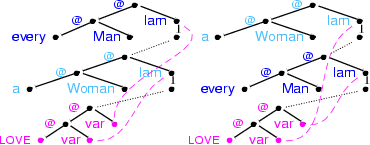6.1.3 Solved Forms: An Example
An example.
A constraint graph...
Since the definition of solved given before forms might be a little too much on the abstract side, let's have a look at our running example ``Every man loves a woman'' again. Remember that the corresponding original constraint is (where, again, abbreviations like  stand for the simple
stand for the simple  -structures).
-structures).

...two of its solutions...
Two of its solutions are the following  -structures. (In fact these are the only solutions we've been interested in so far. But remember that we can get lots of other solutions by integrating new material):
-structures. (In fact these are the only solutions we've been interested in so far. But remember that we can get lots of other solutions by integrating new material):

...and its two solved forms.
Now while the constraint graph has an infinite number of solutions, it has precisely two solved forms:

If you look at the solved forms, you'll see that they're very close to the  -structures -- the graphical difference only consists in the dominance edges, which allow the addition of extra material. We can get from the solved forms to the two solutions that we saw above by simply identifying the end points of each dominance edge.
-structures -- the graphical difference only consists in the dominance edges, which allow the addition of extra material. We can get from the solved forms to the two solutions that we saw above by simply identifying the end points of each dominance edge.
However, it is important to remember that the solved forms are not solutions, i.e.  -structures! They are still constraint graphs. They do have the special property that if you disregard the binding edges, these graphs are trees, but they can still contain dominance edges.
-structures! They are still constraint graphs. They do have the special property that if you disregard the binding edges, these graphs are trees, but they can still contain dominance edges.